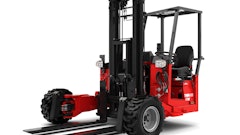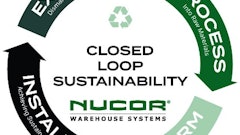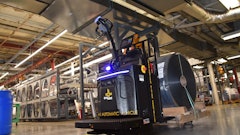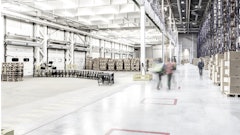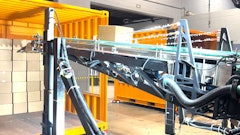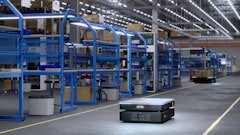
With warehouses having to be more agile and responsive than ever before to the demands of the marketplace, food and beverage companies are looking to their warehouse management solutions (WMS) solutions to squeeze more productivity, efficiency and quality from their supply chains. This means enabling visibility from supplier to food manufacturer to distributors and retailers. Yes, visibility has been there for quite some time, but today’s version is getting ever more granular.
Companies want the best technology offering the best total cost of ownership to apply to their business operations. “We see that being leveraged not necessarily with different best-of-breed components, but by taking a holistic view from an integrated perspective that accommodates logistics, distribution, and customer service,” notes Rik Schrader, senior vice president, global sales and marketing, supply chain, for Retalix U.S., Inc. in Plano, TX.
The current versions of WMS offer easy new modular integrations. “The client server systems of the ’90s came as one big executable so they were harder to swap up components individually,” says Rory Granos, global director of process industry solutions for Infor in Alpharetta, GA. “There is less a need to rip and replace with today’s versions and you can improve your system incrementally, so total integration is quicker and costs a lot less than that one big executable.”
So companies are now looking for that additional quarter of a point to one point to the bottom line, while considering the acceptable and comfortable return on investment the new systems offer. Here are four top trends in the marketplace.
THE GOLDILOCKS FACTOR
Too much inventory: not a good thing. Out-of-stocks: also not a good thing. Schrader at Retalix reports that it costs the industry about $30 billion annually for having too much inventory in the pipeline. On the other hand, the industry loses between $7 billion and $12 billion annually due to out-of-stocks, he says. So how do companies achieve the balance so they can brand themselves as top-level service providers?
Companies are focusing on a pull environment by monitoring store-level forecasting, says Schrader. Creating a highly collaborative environment with suppliers and retailers can reduce friction in the supply chain.
“It’s about having a single version of the truth shared in a real-time environment,” continues Schrader. “It comes down to deploying intelligence at the store level that not only analyzes data going through the point of sale, but also considers promotional activities while taking into account differing shrink components. Then I can know how much product needs to pass through the supply chain to assure products are on the shelf when the consumer wants them.”
A customer-centric environment requires an agile and flexible technology piece to respond to the changing needs of the marketplace, Schrader says. “It also has to be adaptable because processes change over time.”
Today’s WMS solutions have the capability to allow operators to change on the fly. “They want users to be able to take control of business rules immediately so they can make slight changes to processes to allow them to be more agile,” explains Schrader.
Whether this means moving from RF to voice technology or changing the work flow of a current procedure—these changes need to be easy to deploy.
“WMS solutions are reacting to these kinds of situations quickly, and they are deploying them to the operations staff to get that extra layer of efficiency hitting the bottom line,” says Schrader.
Schrader reports that removing the friction from the supply chain can save 15 percent to 30 percent in direct labor costs and another 10 percent to 20 percent in inventory reduction.
CROSS-DOCKING = EFFICIENT DCS
Product proliferation, especially in the beverage industry, is bursting the seams of warehouses. Because the beverage industry’s constant quest for that next great flavor or the newest size, the number of SKUs is expanding exponentially to provide these unique products and their corresponding labels, says Granos at Infor.
“At the warehouse level, every one of those product derivations has to get stocked and that is when you run into the challenge of successfully turning your inventory,” says Granos.
These companies are also active merger and acquisition participants. All of these activities challenge warehousing space, forcing managers to become innovative in optimizing available space so they don’t have to think about investing in additional warehouse construction.
“To deal with these situations, we see increased usage of cross-docking,” says Granos. There is also an increased use of wave picking or RFID to move products through the warehouse more efficiently in order to achieve full truckloads on the outbound.
Companies are monitoring more closely what is happening at the store level and they are tracking their inventory a lot better.
“You want to be able to move your hotter products that keep flying off the shelves onto a pallet and get them loaded onto a truck with as few steps as possible. The way to do this is through cross-docking,” says Granos. “If you had to put those products away and then pick them, you add time and costs and you end up with fewer full truckloads on the outbound, which will increase your operational costs.”
The most important thing, continues Granos, is to have the right inventory on full trucks.
Asset management is also an important consideration, adds Granos. “Preventative maintenance assures your forklifts and conveyors are ready to use when you have a truck waiting at your dock door.”
SEEKING COMMODITY PRODUCTS
Lot management and control has long been of interest to the industry, but focus in robust track-and-trace capabilities is expanding into commodity products, particularly to vegetables, reports Richard Kirker, director of SCM solutions management for SAP Labs LLC.
“The recent salmonella outbreaks in lettuce and spinach have urged companies to be able to trace back to the original farm where the contamination may have occurred,” explains Kirker. “We saw the same kind of thing when the meat industry had to deal with avian flu. Now this industry has to be able to track back to certain ranches or farms.
“We see this activity happening more with vegetables now. So having solutions in place—or at least starting to think about increased track-and-trace requirements—is probably a good idea.”
Kirker says SAP’s robust functionality in the pharmaceutical industry is giving the company traction in disparate industries—including the food industry.
“From an operational standpoint, this requires a lot of discipline in the ability to capture data,” he says. “This also requires a significant organizational change and there has to be change management in controlling your products to this degree. This is a pain point for some companies.”
The major changes include controlling inventory at a more granular level. “When you switch to lot control, you have to make sure each product is labeled and you can’t commingle products if you want to track them effectively,” explains Kirker.
“You also have to be able to share all the data across the enterprise and locate a lot quickly for a recall or a trace. You have to control discrete batches with a system that will reduce the impact of a recall. Then from a regulatory standpoint, the demands are increasing to have this data and to produce it quicker. So there is an organizational impact and you have to have the proper tools in place to do this.”
If this infrastructure is not in place, companies can face going out of business, as was the case for a meat company facing a major recall. It did not have a good system for tracking and tracing. “They had to recall a year’s worth of production because they couldn’t accurately determine which lots the problem occurred in,” Kirker says. The company went out of business and subsequently was acquired by a competitor.
VOICE, LABOR MANAGEMENT TRENDS
The trends in WMS technology are driven by two main engines: efficiency and quality. Voice and labor management are two solutions designed to achieve these goals, whether they are used independently or combined with one another, says Keith Menking, vice president and general manager for WMS at AFS Technologies in Dallas.
“They each produce efficiency and quality when used independently, and they complement each other when used together.” There can be exponential savings. However, each technology stands on its own percentage savings,” says Menking.
The benefit of using voice is that operators can work hands-free and does not have to change focus constantly while talking their way through picking tasks. “There is voice verification that the task has been completed, so quality increases,” says Menking. “There is a significant expense involved in rework, so when you minimize errors, you minimize rework expense.”
Another benefit to voice is it simplifies cycle counts, as the operator can do a count and generate a replenishment request as he or she picks an order. AFS uses Vocollect for its software and Psion Teklogix for its handheld devices. Menking says savings could range between 10 percent and 25 percent, and 99.8 percent accuracy is not uncommon. “With the current economic conditions, this is an inexpensive capital investment that has a profound impact on the bottom line.”
Labor management is the process of applying a standard value against each task and having the ability to measure against that standard, explains Menking. “There is an easily achievable reduction of 10 percent in labor costs, with much higher savings possible. Once you start tracking and reporting labor activities, you can manage overall operation costs more effectively.”
A warehouse using neither voice nor labor management can expect combined labor savings of 20 percent to 40 percent when it implements both voice and labor management.
Labor management can be taken to a higher level through engineering the warehouse into X, Y and Z coordinates. “What is happening is you are describing to the application the physical dimensions of the warehouse,” Menking explains. “So for a given task, based on the unit and how far away it is from the operator, the application can automatically calculate how long it should take for the operator to complete the task.”
Menking acknowledges there is a material investment required for this fine-tuned labor management application. “When you are engineering labor standards, there is a lot of planning involved and the precise description of your warehouse is very critical for a successful implementation.”
FUTURE PERSPECTIVES
A common knee-jerk reaction to current economic conditions could lead some companies to want to slice costs, says Schrader at Retalix. In times like these, that additional half point to one point of margin at the retail level becomes more enticing. “Astute market leaders are seizing this opportunity to invest capital to lower operational costs.”
Granos at Infor expects a wave of aggressive WMS replacement.
“Analysts predict this will happen because the systems built in the ’80s and ’90s were customized for the trends during that time,” says Granos. “WMS solutions today have a whole new set of capabilities to handle the requirements of today’s market such as turning inventory more quickly and efficiently while minimizing labor costs.”















